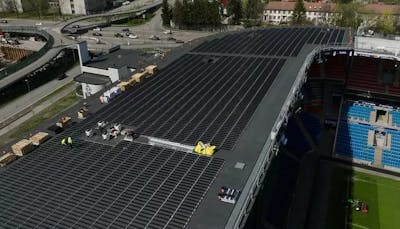Oslopolitan Voices: How Oslo is Driving the Green Revolution
This article by Ksenia Karpova, a former e-commerce manager at a solar energy startup, explores Oslo's path to sustainability and its green revolution. Learn about key initiatives such as Ullevaal Stadium's vertical solar panels, the Vertikal Nydalen building, and efforts to clean up Oslo fjord. Read exclusive insights from Cori Ready, COO of Marea, shared specifically for this piece.

E-bench with solar panel
Photo: VisitOSLO/Didrick Stenersen
In the heart of Norway's capital, Oslo, a green revolution is well underway. Energy-efficient housing is on the rise, bees are buzzing atop rooftops, and fossil-fuel cars are being ushered off the streets. Just a few years ago, Oslo’s port was bustling with trucks filling the air with exhaust fumes, and endless rows of shipping containers dominated the landscape.
Today, a quiet hum of electric and hybrid vehicles has replaced the noise. On the cleared land above, the newly built MUNCH Museum and modern library stand as symbols of Oslo’s green transformation, redefining the city skyline with sustainability at its core. Step by step, Oslo is becoming a haven for those passionate about environmental progress and eager to be part of a greener future.
Oslo has been working to improve its environment for quite some time. The issue of insufficient environmental quality was first raised in 1998, leading to a significant step toward sustainable urban development.
Today, 26 years later, the city's green policy encompasses a range of initiatives, such as reducing harmful emissions by 95% by 2030, addressing climate change, enhancing residents' mobility, and effectively managing waste and wastewater. Renewable energy and green tech also seamlessly integrate into the infrastructure and business ecosystem. Oslo was also the first city in the world to have a climate budget.
Author: Ksenia Karpova
Hi, I am Ksenia. Until recently, I worked as an E-commerce Manager in a solar energy startup, but this autumn I fulfilled my dream of being a storyteller by sending an email to Oslopolitan, and here we are! The article you are reading now is my first attempt to tell a story about Oslo and it's quirky unique character of its on. I want my readers to experience Oslo´s quaint past and, hopefully, very green future. But I have to admit: making you fall in love with my favorite city is a manipulative process. It is also a deeply satisfying one.
Key Green Initiatives Transforming Oslo
Power Play: How Ullevaal Stadium’s Vertical Solar Panels Are Shaping Norway’s Renewable Future
Although the Norwegian national football team may not be the most renowned on the international stage, their home stadium made it to the news with a world record: in June 2024, Ullevaal Stadium became a global leader in renewable energy innovation with the installation of the world’s largest rooftop vertical solar panel array. 1,242 solar panels stretching across the roof are producing 250,000 kilowatt-hours of electricity annually. Which is around the energy needed to power 71 households for a whole year. Vertical solar panels represent a promising new technology poised to significantly impact the energy transition, supporting the EU’s ambitious goal of reaching 42.5% renewable energy by 2030. Adopting this technology could help stabilize energy prices across Europe while enhancing energy security.
But how effective is this technology during Norway's dark, cold winter months? Surprisingly, it is very effective! Unlike traditional panels, vertical arrays can capture sunlight at low angles, maximizing energy generation during shorter days. While overall energy production is lower in winter compared to summer, these panels continue to generate a reliable amount of electricity, contributing to energy security year-round.

Ullevaal Stadium’s Vertical Solar Panels
Photo: OverEasySolar.com
Vertikal Nydalen: Norway’s First Naturally Climatized Mixed-Use Building
Let's travel to the northwestern part of Oslo where a former parking space by the Akerselva river has been transformed into Norway´s first combination building with natural air conditioning. Completed in 2023, Vertikal Nydalen is a 10,000-square-meter structure that integrates offices, restaurants, and residences while pioneering innovative environmental technology. The 18-floor building significantly reduces energy use through its natural ventilation system, which harnesses outdoor air to maintain a comfortable indoor climate. It also boasts geothermal heating and cooling, solar panels, and heat-retaining concrete, which collectively cut CO2 emissions by 51%. Vertikal Nydalen is a game-changer in sustainable urban design.
"Many industry professionals would say that it is madness to drop the modern ventilation systems, and we had to get a dispensation from both the energy and indoor climate requirements to make this happen. In other words, we have "broken" a lot of rules, and people are happier than ever. With Vertikal Nydalen, we are challenging current practice in several ways. We are breaking new ground to create a building that combines a good indoor climate, low energy demand, low CO2 emissions and low operating costs," says Niels Lassen, Chief advisor at Skanska. (quote taken from Skanska.no and translated by Ksenia Karpova)
Vertikal Nydalen is a part of the FutureBuilt program involving six municipalities in the Oslo region, along with Bergen, Trondheim, and Stavanger, aimed at fostering climate-friendly urban development.
As you stroll along the river, be sure to check out the unique building at Gullhaug Torg 2a, Oslo.

Vertikal Nydalen
Photo: Astrid Westvang, licensed under CC BY-NC-ND 2.0. Flickr.com
From Fjord to Future: How Oslo's Ocean Heroes Are Driving a Green Revolution
The ocean is an iconic symbol of the city. However, the Oslofjord faces serious environmental challenges. Luckily, many people in Oslo are working hard to create solutions and hope.
One of Ksenia's personal favorites is Marea, a startup focusing on restoring and preserving marine ecosystems. Cori Ready, COO of Marea and an Oslopolitan of 9 years, answered Ksenia's questions exclusively for Oslopolitan.
"Marea is a community-driven non-profit interested in fixing problems from the bottom up. Through our community-powered adoption program, we are attempting to work on the restoration of kelp forests and other habitats," says Cori Ready.
By cultivating and planting sugar kelp and other marine "engineering species" such as tunicates, we can help create important habitats for fish and other marine organisms. At the same time, these species take nutrients and particles out of the water, which creates a cleaner sea with better visibility, so that seaweed and kelp can get better lighting and growth.
"Everyone who lives in Oslo and swims, saunas, kayaks, floats, sunbathes, reads at the beach or has children who play in the water, I am sure, would love to see a thriving healthy fjord and that is why we make it easy to become an adoption subscriber and for a small monthly fee, you can adopt a marine installation," adds Cori.
Cleaning the ocean, one drop at a time—Allott is transforming the Oslo Fjord with innovative solutions for a plastic-free future.
Allott, a Norwegian non-profit organization, is committed to cleaning the Oslo Fjord by removing plastic and microplastics from its waters. Their primary initiative is the deployment of “Ryddebrygger” (cleaning piers), which can filter up to 1.5 million liters of seawater daily, capturing debris as small as one millimeter. A new cleaning pier at the Opera in Bjørvika marks the start of this impactful project. Dedicated to the UN’s sustainability goals, Allott allocates 100% of its donations to purchasing and operating cleaning equipment. Developed by Norwegian company Clean Sea Solutions, the Ryddebrygge stands as a key tool in restoring es alike. Through transformative projects and community-driven initiatives, Oslo invites everyone to be part of its journey toward a greener future. For those looking for a dynamic, eco-conscious urban lifestyle, Oslo provides the perfect blend of opportunity and purpose—an open call to join the green movement.the health of the fjord. I am sure some of you saw this crucial initiative when doing ocean dips after saunas at Oslo Badstuforening!

Photo: Marea/Facebook page
Oslo: A Century of Identity, Four Centuries of Progress, and a Green Future Ahead
Oslo’s green revolution is reshaping the city, offering a sustainable and innovative environment for residents, expats, and businesses alike. Through transformative projects and community-driven initiatives, Oslo invites everyone to be part of its journey toward a greener future. For those looking for a dynamic, eco-conscious urban lifestyle, Oslo provides the perfect blend of opportunity and purpose—an open call to join the green movement.
Oslo’s commitment to sustainability was internationally recognized when it was named the European Green Capital in 2019. Awarded by the European Commission, this title highlighted Oslo's success in cutting greenhouse gas emissions, promoting green spaces, and pioneering innovative environmental solutions. Throughout that year, the city engaged residents, businesses, and organizations in initiatives aimed at fostering a greener urban environment, laying the groundwork for its ongoing green revolution.
This year, 2024, is special: Oslo marks two significant milestones—400 years since the great fire that led to the founding of Christiania and 100 years since reclaiming its original name, Oslo. These anniversaries symbolize the city’s transformation—from a medieval settlement to a trailblazer in sustainability and urban renewal.
As our new home away from home, Oslo exemplifies a deep-rooted Norwegian respect for the natural world, an identity that drives its forward-thinking approach to green innovation. And we are here to support it!


